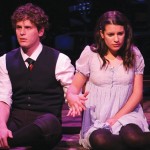Each scene is like a mini-musical, with its own beginning, middle, and end. Before you write any dialogue, decide how the scene begins. Playwright David Mamet asks three questions: “1. Who wants what from whom?, 2. What happens if they don’t get it?, 3. Why now?” That last question is about the point of attack, the complication in the beginning that kicks the scene into motion.
In the middle of the scene, keep three things in mind. First is the objective. This is what the character wants so much now that they have to speak up. Second is the obstacle. This is the roadblock in the way of the character’s objective. Third is tactic. This is how the character plans to get around that obstacle. But don’t let their first plan succeed too easily — or the story is over. When the first tactic doesn’t work completely, the character tries another … and perhaps another, “until finally” we reach the climax of the scene.
By the end of the scene, the character has run out of tactics for now and either doesn’t have what they want or has some of what they want (but not everything).
How should you write dialogue? Look to your character sketches for words and phrases that sound real for them. If you’re not sure, cast the show in your mind with friends or celebrities. Second, study how your friends and family listen (or don’t) to each other. And finally, remember that people don’t always say what they mean.
How should you not write dialogue? There are two common problems: overwriting and tired writing. One type of overwriting is exposition. Dialogue is about today’s conflict, not yesterday’s. If we must know something about the past, have a character use it as ammunition in today’s conflict. A second type is filler. Avoid padding like “Well, you see, John.” If it isn’t important to the character, it won’t be to the audience. A third type is the monologue. People rarely get to talk for long in real life. We constantly interrupt each other — trying to achieve our own objective or obstruct someone else’s. If you find yourself compelled to write a monologue, it could mean you’ve found a powerful song moment.
One type of tired writing is the cliché. If a character isn’t talking to reach an important objective, the dialogue can feel boring. Another type is writing “on the nose.” Characters don’t always say what they’re thinking. They use misdirection as one tactic to hide their objective. A third type is the soapbox. People talk about what’s important in the scene, what’s at stake. Like the monologue, if you find yourself compelled to write a soapbox speech, it could mean you’ve found a powerful song moment.
Now, using your outline as a guide, begin listing the possible scenes in your musical and writing dialogue for them. As you hear the characters talk, keep an ear out for where songs may occur, where the emotions start to bubble up. Scenes usually build to a song, though they sometimes flow from one. We’ll work on the songwriting later. For now, keep writing dialogue and reading it aloud to yourself (or another person) to hear how it sounds.
Before you get too far, though, watch the second half of Young Jean Lee’s workshop, which is about writing dialogue, and watch John Cariani’s half-hour session for Broadway Teachers’ Workshop, which includes three exercises to help you write dialogue.
That’s the basics of the book. Consider reading Words with Music (1972) by Lehman Engel, for more about libretto writing, and check your local library’s e-book and audiobook services for the following libretto collections: American Musicals (2014) by Laurence Maslon, Great Musicals of the American Theatre, Vol. 1 and Vol. 2 (1976) and Great Rock Musicals (1979) by Stanley Richards, and The New American Musical (2001) by Wiley Hausam.
Take time to browse the playlist of theater livestreams on Theater Development Fund’s site and the videos at Broadway.com’s Living Room Concerts and The Actors Fund’s Stars in the House. There’s also the new livestream reunion of the original cast of Spring Awakening, the recent release of “Bossed Up” (the second-act opening song cut from Mean Girls during its world premiere in D.C.), and a behind-the-scenes look at every song in Ragtime from Ahrens and Flaherty.
Vocabulary from this week: antagonist (opponent), the character in conflict with the hero; exposition (backstory), what happened before the story begins; objective (motivation), what a character wants; obstacle, what stands in the way of a character’s objective; “on the nose,” a character saying exactly what they think; protagonist (hero), the character we follow in the story; score, the music of the show; script (book, libretto), the words of the show; subtext, a character’s unspoken thoughts and objectives; and tactic, how a character gets what they want.
Next, the song moments.

